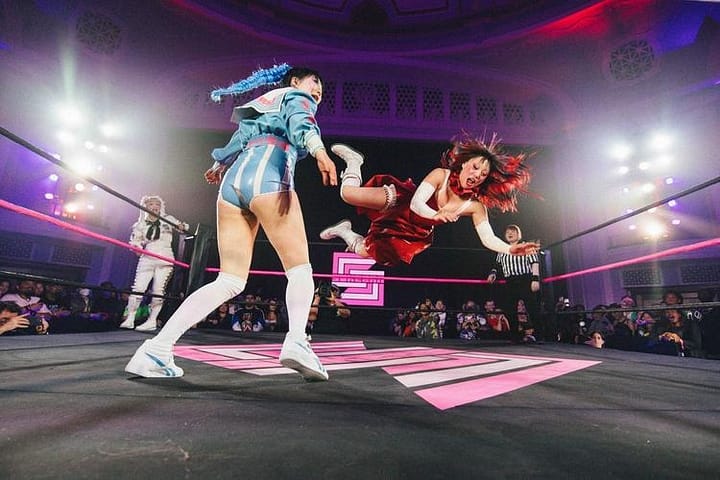SUKEBAN: JAPANESE FEMALE PRO-WRESTLING CHAMPIONSHIP
Trinity Auditorium
Los Angeles
May 30
“Call her babyface,” proclaims an announcer in a black velvet suit and Ray-Bans. He looks slick, like a Japanese Elvis Costello impersonator you might find stumbling around Hollywood Boulevard, down on his luck. Instead, he’s bathed in pink light in a wrestling ring, trumpeting the names of competitors into a microphone. After much fanfare, the herculean Babyface emerges in a powder blue latex dress. She’s so elegant that she seems plucked from a Tokyo runway. Tonight, though, she’s here — to get punched. Pouting, she throws herself onto the mat. “Babyface! Babyface!” chants the crowd.
There’s a tender ecstasy to hearing a wrestling crowd -– typically associated with rage, masculinity, and bloodlust — cry “Babyface” in unison.
Then again, this is not a regular wrestling match; it’s Sukeban, the Japanese all-female pro-wrestling league. Hundreds of fans have gathered at the Trinity Auditorium on a cloudy Thursday evening to watch the team compete in an ornate marriage of theater, fashion, and anime culture. The crowd ranges from anime fans dressed in Harajuku-inspired clothing to all-out wrestling enthusiasts.
Perhaps unsurprisingly, celebrities appear: a bored-looking Diplo, Steven Yeun, and Greta Lee. (At one point, to the crowd’s glee, the rapper Saweetie takes the wrestling stage, only to leave minutes after her arrival.)
What does the pastel-colored, satin bow-tied world of Sukeban have to offer? To start, these wrestlers mean business. They’re brats, dripping with attitude. Sporting latex costumes and blue wigs, the wrestlers body slam one another, putting each other in headlocks, hooks, and ties; in one instance, they pummel each other with trash can lids.
Of course, the fights are highly choreographed, but it hardly matters. The crowd winces at each punch, hisses at foul play, and cheers when competitors get back on their feet. To parse out the legitimacy of the combat would be missing the point.
There’s a poetry and pageantry to their brawls so performative in its violence and fury that it mutates into softness. As one wrestler falls to the mat and pantomimes sobbing into her hands, the melancholy she conveys feels genuine and overwhelming.
A plot occasionally emerges throughout the night. Underdogs and bullies grapple against each other in battles of spirit and highly stylized combat. Much like a drag show, each wrestler embodies a character. In this case, they’re the kind you might expect from a Quentin Tarantino film: rage-filled and revenge-thirsty women who spare no one. One wrestler, Otaku-chan, appears as a bashful schoolboy. Another, Lady Antoinette, arrives in a rose-colored corset, throwing her wig to the ground as she approaches the ring. (She fights dirty too, choking her opponent with a folding chair.) A fighter named Atomic Banshee emerges in ripped fishnet tights and black eye shadow, like a hair metal rock star. Taken altogether, this bombastic cosplay articulates something refreshing about masculinity — especially in the wrestling ring, with its oiled muscles and bloody noses, conventional manhood is a noisy costume too.
Finally, a Sukeban World Champion is named: Commander Nakajima, who delivers a devastating blow to her opponent. The audience celebrates loudly as she thrusts the championship belt into the air. As we spill into the street after, I overhear a few people’s remarks about the choreographed nature of the night. It’s a tired point to make. Sure, the wrestling itself is fake. But Sukeban asks us to suspend disbelief for 90 minutes, to be swept away by strange and glorious spectacle. After all, not all victories need be drawn in blood.






